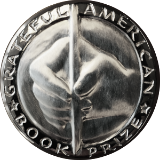May 1 — May 15, 2021
History Matters
Showing our children that their past is prelude to their future
On May 5, 1961, Navy Commander Alan Bartlett Shepard Jr. became the first American in space. It was just a 15-minute mission — memorable to the nation — but too late to outwit the competition. Soviet cosmonaut Yuri Gargarin astounded the world when he orbited the earth — once — in the Vistok 1.
Shepard’s Freedom 7 capsule, however, foreshadowed America’s dominance; less than a decade later, the Apollo 11 mission “silenced” the Russians, and catapulted Neil Armstrong, Edwin “Buzz” Aldrin, and Michael Collins to the moon.
Shepard was ranked fifth to walk the lunar surface after the Apollo 14 mission.
The Grateful American Book Prize recommends Light This Candle: The Life and Times of Alan Shepard by Neal Thompson.

The American Revolution was an unexpected victory for the colonists. They won an immense land with a myriad of perks and perils, but the only way to traverse its complex vastness was to join a wagon train. It was a complicated and difficult crossing that many did not survive.
Then, on May 10, 1869, everything changed; two railroads completed the task of laying the tracks from “sea to shining sea”. The presidents of the Union Pacific and Central Pacific railroads met at Promontory, Utah to drive the last spike into the rails of the nation’s first transcontinental railway.
Seven years earlier, land grants and loans from Congress had equipped them with the fiscal flexibility to build, but according to History.com, “In their eagerness for land, the two lines built right past each other, and the final meeting place had to be renegotiated.”
To learn more about how the West was subdued, the Grateful American Book Prize recommends Full Steam Ahead: The Race to Build a Transcontinental Railroad by Rhoda Blumberg.

In order to determine what it would require to mollify a newly acquired, undomesticated expanse of land, President Jefferson determined that a survey was imperative; he selected two explorers Meriwether Lewis and William Clark — to manage the mission.
America was just over 21 years old, but the Louisiana Purchase transaction suddenly added 828,000 acres, and the equivalent of approximately 15 states.
Lewis and Clark started their journey in St. Louis with 55 men on May 14, 1804.
According to History.com, “The expedition traveled up the Missouri River in a 55-foot-long keelboat and two smaller boats. In November, Toussaint Charbonneau, a French-Canadian fur trader accompanied by his young Native American wife Sacagawea, joined the expedition as an interpreter. The group wintered in present-day North Dakota before crossing into present-day Montana, where they first saw the Rocky Mountains.”
They met up with the Shoshone Indians when they reached Colorado, crossed the Clearwater and Snake rivers in canoes, and followed the Columbia River to the Pacific Ocean on November 8, 1805.
Two and a half years later, the expedition returned — in triumph — to St. Louis with thirty-three men. They had mapped out new lands and brought back journals about the Indian tribes they encountered; scientific notes of the flora and fauna they encountered, and a claim to the Oregon Territory.
For more information, the Grateful American Book Prize recommends Sacajawea by Joseph Bruchac.

History Matters is a biweekly feature courtesy of The Grateful American Book Prize.




